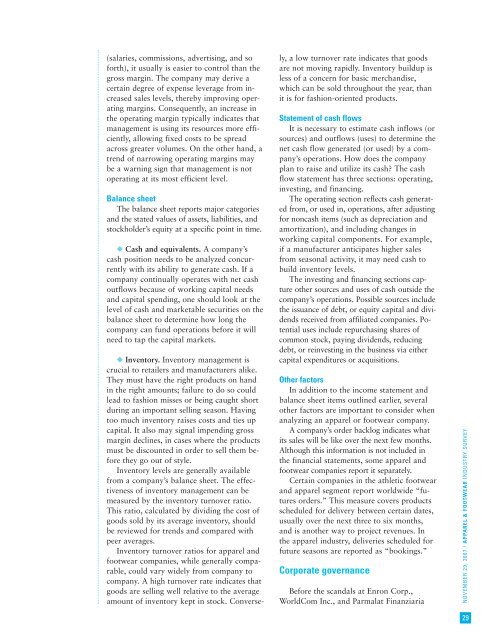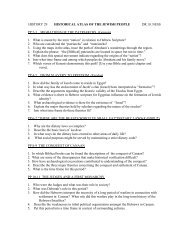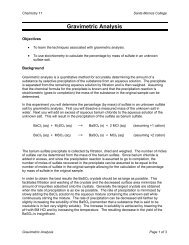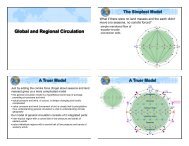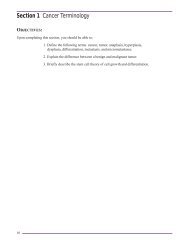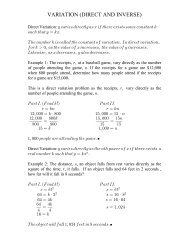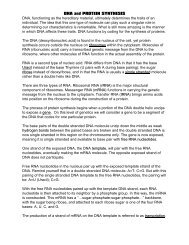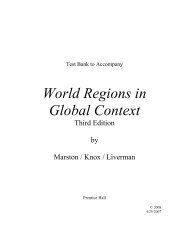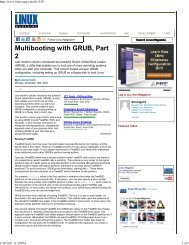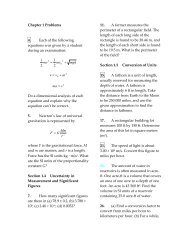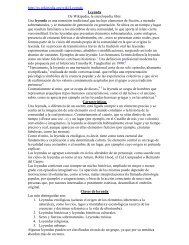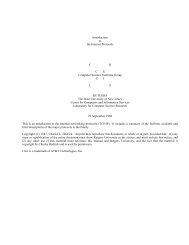You also want an ePaper? Increase the reach of your titles
YUMPU automatically turns print PDFs into web optimized ePapers that Google loves.
(salaries, commissions, advertising, and so<br />
forth), it usually is easier to control than the<br />
gross margin. The company may derive a<br />
certain degree of expense leverage from increased<br />
sales levels, thereby improving operating<br />
margins. Consequently, an increase in<br />
the operating margin typically indicates that<br />
management is using its resources more efficiently,<br />
allowing fixed costs to be spread<br />
across greater volumes. On the other hand, a<br />
trend of narrowing operating margins may<br />
be a warning sign that management is not<br />
operating at its most efficient level.<br />
Balance sheet<br />
The balance sheet reports major categories<br />
and the stated values of assets, liabilities, and<br />
stockholder’s equity at a specific point in time.<br />
◆ Cash and equivalents. A company’s<br />
cash position needs to be analyzed concurrently<br />
with its ability to generate cash. If a<br />
company continually operates with net cash<br />
outflows because of working capital needs<br />
and capital spending, one should look at the<br />
level of cash and marketable securities on the<br />
balance sheet to determine how long the<br />
company can fund operations before it will<br />
need to tap the capital markets.<br />
◆ Inventory. Inventory management is<br />
crucial to retailers and manufacturers alike.<br />
They must have the right products on hand<br />
in the right amounts; failure to do so could<br />
lead to fashion misses or being caught short<br />
during an important selling season. Having<br />
too much inventory raises costs and ties up<br />
capital. It also may signal impending gross<br />
margin declines, in cases where the products<br />
must be discounted in order to sell them before<br />
they go out of style.<br />
Inventory levels are generally available<br />
from a company’s balance sheet. The effectiveness<br />
of inventory management can be<br />
measured by the inventory turnover ratio.<br />
This ratio, calculated by dividing the cost of<br />
goods sold by its average inventory, should<br />
be reviewed for trends and compared with<br />
peer averages.<br />
Inventory turnover ratios for apparel and<br />
footwear companies, while generally comparable,<br />
could vary widely from company to<br />
company. A high turnover rate indicates that<br />
goods are selling well relative to the average<br />
amount of inventory kept in stock. Converse-<br />
ly, a low turnover rate indicates that goods<br />
are not moving rapidly. Inventory buildup is<br />
less of a concern for basic merchandise,<br />
which can be sold throughout the year, than<br />
it is for fashion-oriented products.<br />
Statement of cash flows<br />
It is necessary to estimate cash inflows (or<br />
sources) and outflows (uses) to determine the<br />
net cash flow generated (or used) by a company’s<br />
operations. How does the company<br />
plan to raise and utilize its cash? The cash<br />
flow statement has three sections: operating,<br />
investing, and financing.<br />
The operating section reflects cash generated<br />
from, or used in, operations, after adjusting<br />
for noncash items (such as depreciation and<br />
amortization), and including changes in<br />
working capital components. For example,<br />
if a manufacturer anticipates higher sales<br />
from seasonal activity, it may need cash to<br />
build inventory levels.<br />
The investing and financing sections capture<br />
other sources and uses of cash outside the<br />
company’s operations. Possible sources include<br />
the issuance of debt, or equity capital and dividends<br />
received from affiliated companies. Potential<br />
uses include repurchasing shares of<br />
common stock, paying dividends, reducing<br />
debt, or reinvesting in the business via either<br />
capital expenditures or acquisitions.<br />
Other factors<br />
In addition to the income statement and<br />
balance sheet items outlined earlier, several<br />
other factors are important to consider when<br />
analyzing an apparel or footwear company.<br />
A company’s order backlog indicates what<br />
its sales will be like over the next few months.<br />
Although this information is not included in<br />
the financial statements, some apparel and<br />
footwear companies report it separately.<br />
Certain companies in the athletic footwear<br />
and apparel segment report worldwide “futures<br />
orders.” This measure covers products<br />
scheduled for delivery between certain dates,<br />
usually over the next three to six months,<br />
and is another way to project revenues. In<br />
the apparel industry, deliveries scheduled for<br />
future seasons are reported as “bookings.”<br />
Corporate governance<br />
Before the scandals at Enron Corp.,<br />
WorldCom Inc., and Parmalat Finanziaria<br />
NOVEMBER 29, 2007 / APPAREL & FOOTWEAR INDUSTRY SURVEY<br />
29


